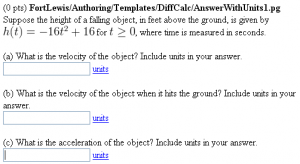Difference between revisions of "AnswerWithUnits1"
Jump to navigation
Jump to search
Paultpearson (talk | contribs) m |
Paultpearson (talk | contribs) |
||
| Line 5: | Line 5: | ||
This PG code shows how to require students to enter units with their answers. |
This PG code shows how to require students to enter units with their answers. |
||
</p> |
</p> |
||
| − | * Download file: [[File:AnswerWithUnits1.txt]] (change the file extension from txt to pg when you save it) |
||
| + | * File location in OPL: [https://github.com/openwebwork/webwork-open-problem-library/blob/master/OpenProblemLibrary/FortLewis/Authoring/Templates/DiffCalc/AnswerWithUnits1.pg FortLewis/Authoring/Templates/DiffCalc/AnswerWithUnits.pg] |
||
| − | * File location in NPL: <code>FortLewis/Authoring/Templates/DiffCalc/AnswerWithUnits.pg</code> |
||
<br clear="all" /> |
<br clear="all" /> |
||
| Line 154: | Line 153: | ||
Context()->texStrings; |
Context()->texStrings; |
||
BEGIN_SOLUTION |
BEGIN_SOLUTION |
||
| − | ${PAR}SOLUTION:${PAR} |
||
Solution explanation goes here. |
Solution explanation goes here. |
||
END_SOLUTION |
END_SOLUTION |
||
Revision as of 16:48, 16 June 2013
Answer is a Number or Formula with Units
This PG code shows how to require students to enter units with their answers.
- File location in OPL: FortLewis/Authoring/Templates/DiffCalc/AnswerWithUnits.pg
| PG problem file | Explanation |
|---|---|
|
Problem tagging: |
|
DOCUMENT(); loadMacros( "PGstandard.pl", "MathObjects.pl", "parserNumberWithUnits.pl", "parserFormulaWithUnits.pl", ); TEXT(beginproblem()); |
Initialization:
We load |
Context("Numeric")->variables->are(t=>"Real");
$h = Formula("-16 t^2 + 16");
$v = $h->D('t');
$v1 = $v->eval(t=>1);
$a = $v->D('t');
$answer[0] = FormulaWithUnits("$v","ft/s");
$answer[1] = NumberWithUnits("$v1","ft/s");
$answer[2] = FormulaWithUnits("$a","ft/s^2");
|
Setup:
We use the differentiation operator |
Context()->texStrings;
BEGIN_TEXT
Suppose the height of a falling object, in feet
above the ground, is given by \( h(t) = $h \)
for \( t \geq 0 \), where time is measured in
seconds.
$BR
$BR
(a) What is the velocity of the object? Include
units in your answer.
$BR
\{ ans_rule(20) \}
\{ helpLink("units") \}
$BR
$BR
(b) What is the velocity of the object when it
hits the ground? Include units in your answer.
$BR
\{ ans_rule(20) \}
\{ helpLink("units") \}
$BR
$BR
(c) What is the acceleration of the object?
Include units in your answer.
$BR
\{ ans_rule(20) \}
\{ helpLink("units") \}
END_TEXT
Context()->normalStrings;
|
Main Text:
Don't forget to use |
$showPartialCorrectAnswers = 1;
foreach my $i (0..2) {
ANS( $answer[$i]->cmp() );
}
|
Answer Evaluation: |
Context()->texStrings;
BEGIN_SOLUTION
Solution explanation goes here.
END_SOLUTION
Context()->normalStrings;
COMMENT('MathObject version.');
ENDDOCUMENT();
|
Solution: |
